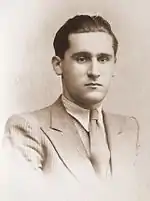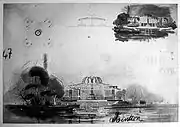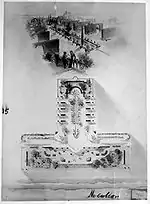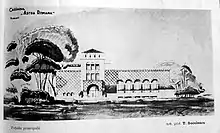Toma Barbu Socolescu | |
|---|---|
 Toma Barbu Socolescu, around 1930. | |
| Born | July 10, 1910 |
| Died | July 21, 1977 (aged 67) |
| Nationality | Romanian |
| Alma mater | École nationale supérieure des Beaux-Arts |
| Occupation | Architect |
| Years active | 1932–1969 |
| Parent |
|
| Relatives | Toma N. Socolescu |
| Awards | Paul Delaon Prize, 1st mention (1938) |
| Design | Functionalism |
Toma Gheorghe Barbu Socolescu a Romanian architect, son of Toma T. Socolescu[1] and grandson of Toma N. Socolescu, functionalist in spite of himself, he had to espouse the directives of the Socialist Republic of Romania.
Biography

Socolescu was born in Ploiești. An architecture graduate of the École nationale supérieure des Beaux-Arts in 1939, he is one of the architects that worked during the time of its studies on the interior of the transatlantic liner SS Normandie, between 1932 and 1935. Initially a university assistant at the Ion Mincu Architecture Institute in Bucharest from 1939 to 1951, he would pursue his career in industrial architecture and large civil buildings.
From 1942 to 1945, he was Design Architect at the CAM (Cassa Autonomă a Monopolurilor Regatului României), a position he would still assume from 1949 to 1951 at the IPC (Institute of Design and Construction). He became Chief Designer Architect at the Design Institute for Industrial Constructions (IPCI) until 1952. From 1952 to 1958, he served as Chief Architect Designer at the Design Institute dor Oil Refineries Institutul de Proiectări pentru Instalații Petroliere IPIP SA). From 1960 to 1967, he acted as Architect Advisor at the Architecture and Buildings Design Institute for Food Industries & Consumers Cooperative Societies.
He ended his career as a professor at the Technical School of Architecture and Town Building (Școala Tehnică de Arhitectură și Construcția Orașelor) from 1967 to 1969.[2]
Barbu Socolescu designed many civil and industrial buildings, including a Pepsi-Cola plant in 1966. Painter, he exhibited his watercolors in an exhibition organized by the Union of Architects of the Socialist Republic of Romania in Bucharest in 1954.
Contests

- 1937: First prize for the sketch competition for a casino project for the Astra Română refinery, in Ploiești, co-directed with his father Toma T. Socolescu – Ploiești.
- April 1938: 1st mention at concours Paul Delaon – Paris.
- 1964: Award of the Architecture and Building State Commission for the canned vegetables factory of Ovidiu, Constanța County.[3]
Memberships
He was a member of several groups of architects:
- Member of the Association of students and former students of the National and Superior School of Fine Arts or Grande Masse of the School of Fine Arts in 1932.
- Société des Architectes Diplômés par le Gouvernement Français[4] since 1939.
- Society of Certified Architects and Corporation of Romanian Architects in 1939.
- Society of Romanian Architects from 1939 to 1946.
- Architects Union of Romanian Socialist Republic since 1953.
Architectural achievements
- Interior decoration of the liner SS Normandie in 1936, under the direction of professor of architecture Roger-Henri Expert.
_interior.jpg.webp)
- Villa of Dr Gheorghiu in Breaza, Prahova County, in 1940.
- Slănic Salt Mine Employee Housing Building (Salina Slănic), Prahova County, in 1942.
- Social complex and canteen of the municipality of Ghimpați, Giurgiu County, in 1942.
- Tobacco manufacturing and fermentation warehouse from the Autonomous Fund of Monopolies of the Kingdom of Romania (CAM) in Râmnicu Sărat and Târgu Jiu, in 1943.
- Salt deposit at Ocna Mureș, Alba County, in 1943.
- Administrative premises, staff accommodation and warehouses from the Autonomous Fund of Monopolies of the Kingdom of Romania (CAM)in Fălticeni, Suceava County, in 1943.
- Oil factory in Craiova, as an external collaborator at the Ministry of Communal Economy and Local Industry, in 1949.
- Cement plant of Bicaz, 1951.
- Various works for the Medgidia and Fieni cement plants: mechanical workshop, cement paste tank, canteen, administrative pavilion, in 1951
- Many other industrial constructions until 1966, including a vegetable canning factory in Ovidiu, near Constanța.
Architectural projects

- Astra Refinery Casino, Ploiești, carried out with his father, Toma T. Socolescu, in 1937.
- Orthodox Church of Predeal in 1956 or 1957, another project carried out with his father.
Sources
- Socolescu family's archives (Paris, Bucharest) including a photographic collection.
 Ion Mincu Architecture and Urbanism University Library, Bucharest.
Ion Mincu Architecture and Urbanism University Library, Bucharest. | Central University Library Carol I, Bucharest
| Central University Library Carol I, Bucharest Revista Arhitectura, journal published by the Society of Architects of Romania from 1906 to 1944. Most issues are available at the Central University Library Carol I.
Revista Arhitectura, journal published by the Society of Architects of Romania from 1906 to 1944. Most issues are available at the Central University Library Carol I. UAR Archives (Union of Architects of Romania) - UAR documentary archives (available on site on request).
UAR Archives (Union of Architects of Romania) - UAR documentary archives (available on site on request). Archives of the Paris School of Fine Arts / AGORHA - Plateforme de données de la recherche de l'Institut national d'histoire de l'art / Dictionnaire des élèves architectes de l’École des beaux-arts de Paris (1800-1968) Dictionary database, Paris.
Archives of the Paris School of Fine Arts / AGORHA - Plateforme de données de la recherche de l'Institut national d'histoire de l'art / Dictionnaire des élèves architectes de l’École des beaux-arts de Paris (1800-1968) Dictionary database, Paris.- International Who's who in Art and Antiques - Second Edition, Ernest Kay (Editorial Director), Great Britain, Melrose Press Ltd, 1976, 525 pages, ISBN 0-900332-37-9
See also
- Technical College of Architecture and Public Works Ioan N. Socolescu.
Notes and references
- ↑ Source Family Socolescu: he will make a more modest career than its capabilities did foreshadowed, subjected to political persecution which his family will suffer.
- ↑ The school changed its name several times until 2001 when it eventually bore the name of his great-uncle Ion N. Socolescu: Colegiul Tehnic de Arhitectură și Lucrări Publice Ioan N. Socolescu.
- ↑ The factory failed in 2005 and has been liquidated. The factory has been emptied of its machines and tools. As of June 2010, the building and its iron structure still remain:
- "Munca Ovidiu, intră în faliment". România liberă (in Romanian). June 24, 2005. Retrieved October 14, 2023..
- "Fabrica "Munca Ovidiu", tăiată la fier vechi". România liberă (in Romanian). October 28, 2005. Retrieved October 14, 2023..
- Siclitaru, Lavinia (November 18, 2005). "Faliment la Munca Ovidiu". Ziua de Constanța (in Romanian). Retrieved October 14, 2023..
- "Din fabrica Munca Ovidiu au rămas numai pereții și câțiva paznici". www.uups.ro (in Romanian). June 9, 2005. Retrieved October 14, 2023..
- ↑ French association: Society of Architects Graduated by the French Government.